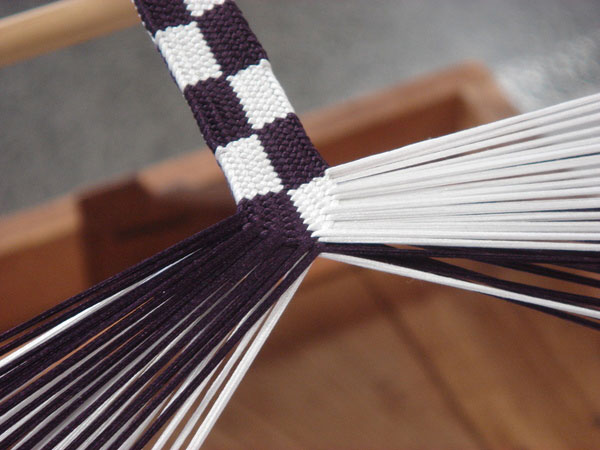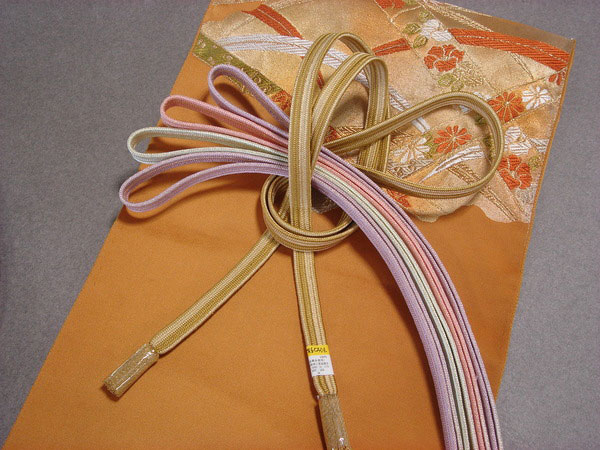
- Other textiles
- Mie
Iga braided cords Iga kumihimo
The finest artisan skills
Beautiful gold and silver silk cords
Description
What is Iga braided cords ?
Iga Braided Cords, called Iga Kumihimo in Japanese, are made in Mie prefecture. Mainly silk threads are used, often in combination with gold and silver threads.
This craft is known for rich silk threads, being dyed in a vibrant range of colors, and outstanding craftsmanship. Those that are braided by hand are especially famous. The cords have a distinct texture because of the tactile nature of braided threads and a lovely silk sheen.
These braided cords have a long history with their techniques being protected while continuously evolving, and handed down through many generations of artisans. Nowadays, along with braided cord obi sash ties (belt for kimono) and other kimono accessories that represent traditional Japanese culture, products like cell phone straps and other items that can be used in our current life style are being developed. The production areas are holding workshops where visitors can make key chains, bracelets and other everyday items and are promoting Iga Kumihimo as a familiar product.
History

The techniques of cord braiding were first introduced from China along with Buddhism, so the cords were mainly used for robes worn by Buddhist priests and decorating scriptures. After the capital was transferred to the Heian Palace (located in Kyoto), braided cords were essential as accessories for the formal court dress of the aristocracy. Sashes made with braided cords have been appreciated for generations up to this day because of its artistic quality. During the Kamakura period (1192-1333), braided cords were used to adorn samurai weapons and armor. In the Muromachi period (1336-1573), they became popular as decorative cords for tea ceremony utensils, and were known and admired across Japan. In the Sengoku period (1467-1568), they were a functional and decorative part of armor, and became an essential part of sword scabbards during the Edo period (1603-1868). With the encouragement of the Edo government, competitive craftsmen making armor and personal ornaments spurred each other which resulted in improving their techniques and skills. The number of braiding techniques increased, and this craft came to be used as cords on pill boxes, half-coats, or tobacco cases. In the Meiji period (1868-1912), a law banning the wearing of swords by samurai came into effect, and this had a hugely negative impact on production. However, braided cords have adjusted to the change of life style and many new products using their traditional techniques have been developed to this day.
General Production Process
- 1. Thread preparation
Raw silk threads are used in combination with gold or silver threads and traditional braiding stands to make delicate braided cords. The raw threads are measured and divided by weight according to the amount necessary for the finished product.
- 2. Dyeing
Threads are evenly dyed based on the design. To obtain shades faithful to a color sample, liquid dyes are mixed, threads are dipped into the dye mixture and then dried. By repeating this, the gradations and depth of the color can be produced. Some designs have subtle gradations, so this process requires high skills and preciseness. Seven different colors of dye are used and the way the colors are mixed depends on the artisan's decision. To dye the threads while changing the percentage of the color mixture and making different shades, the artisan is required to have years of practice, skills and a keen eye for color effects.
- 3. Reeling
The dyed threads are wound around a frame using a hand-reeling instrument.
- 4. Measuring
The length and amount of threads needed for braiding are prepared. The threads are wound around a measuring frame, and at the same time, the number of threads are adjusted.
- 5. Twisting
The measured threads are twisted on a wheel and wound onto reels. Some of the threads are twisted tightly while others are twisted loosely. This makes a difference in the finishing of the product.
- 6. Braiding
There are largely three different types of braiding which are round, square, and flat braiding. Different braiding stands are used to produce the various braiding styles. Commonly used traditional braiding stands are round, square, bamboo, or high. At the height of production in the Meiji period, there were more than eighty braided cord shops in the region. However, the number of shops and skilled artisans have now decreased, and hand-braided cords have become quite rare. Even so, Iga Braided Cords hold a ninety percent share of the production of hand-braided cords in Japan. Today, braiding machines are used for the braiding process and mass production is possible.
- 7. Finishing
To finish the braided cord, both ends of the thread are carefully teased out by hand, tassels are made, and firmly tied with thread before steaming which gives a smooth and beautiful finish. As a final touch, braids are made uniform using a rolling stand. For obi sash ties made from Iga Braided Cords, high-quality silk threads are braided at a high density which makes them pliant and easy to tie. This craft has elegant colors and patterns, as well as durability, and is comfortable when in use.
Where to Buy & More Information
Kumi No Sato
-
Address
-
Tel.+81-595-23-8038
-
ClosedMondays, around the New Year
-
Business Hours9am to 5pm
-
Website































































































































































































































































































